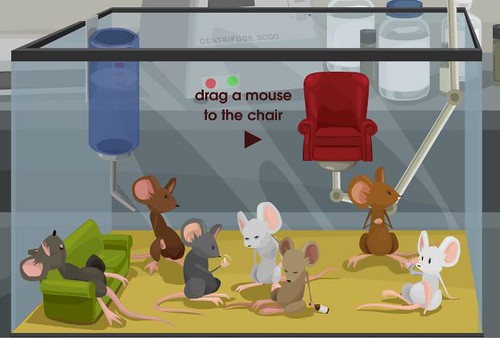This interactive game is a great educational tool, teaching you how various legal and illegal drugs work in the brain.
Have you ever wondered how various drugs work in the brain to produce the symptoms they do? Well, this wonderful interactive website, Mouse Party, shows you the molecular details of how heroin, exstacy, alcohol, marijuana, methamphetamines, cocaine and LSD work.
Note:
The simplified mechanisms of drug action presented in the game are just a small part of the story. When drugs enter the body they elicit very complex effects in many different regions of the brain. Often they interact with many different types of neurotransmitters and may bind with a variety of receptor types in a variety of different locations. For example, THC in marijuana can bind with cannabinoid receptors located on the presynaptic and/or postsynaptic cell in a synapse.
Where applicable, this presentation primarily depicts how drugs interact with dopamine neurotransmitters because this website focuses on the brain's reward pathway. Mouse Party is designed to provide a small glimpse into the chemical interactions at the synaptic level that cause the drug user to feel 'high'.
.


I confess to being a bit less than excited about this game. Some good information, sure, but also a healthy dose of propaganda. It introduces all these chemicals as "drugs of abuse," and yes, they all have the potential to be such, but the reality is that they are often not abused. Glossing that over is implicit support of the indiscriminacy of the War on Drugz That Are Bad, Mmkay?.
Also, as long as we're talking about Bad Addictive Drugs, where the heck is nicotine?
Also -- sorry, forgot this in my first comment -- has physical addictiveness/abuse potential of LSD been established?
The animations are nifty; I wish they'd included psilocybin in there. (Although again its abuse potential is not clear to me.)
And, as long as I'm griping, for the Flying Spaghetti Monster's sake, stop referring to the mythical "ecstasy"!* Most commonly it's MDMA (methylenedioxymethamphetamine) that is referred to by that name, but not always, and that's just... lacking in rigor and introducing unnecessary confusion into a topic on which there's already way too much misinformation out there.
*That's aimed at the game's creators, not at you, GrrlScientist.
Well, I had fun with this. The sound track was pleasing, the chair and gloved, lab-tech's hand and the analytical machinery and the characteristically-zonked or wired mice all made me laugh. How do find this stuff, G/S?
vika, anything can be abused. As far as LSD goes, last time I checked, no physical addictiveness has been found and the lethal dose has not been determined. They give up after finding that 25,000 times the effective was not lethal.
Yes using the term ecstasy shows how poorly this has been put together. There a many street drugs attached to that term, some of them VERY dangerous, with the lethal dose very close to the effective dose.
The best advice is just don't ever do street drugs as you never know what you really are getting.
If you used the animation as your only source of information, you would conclude that effects on dopamine release play a major role in the mechanism of action of THC and related compounds. I understand this to be incorrect (it also makes no sense given cannabis' relative lack of addictive potential).